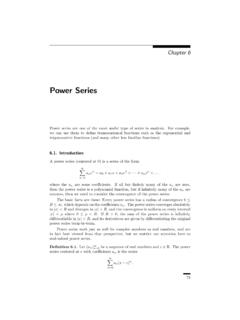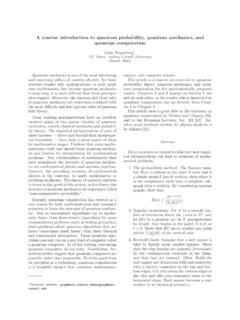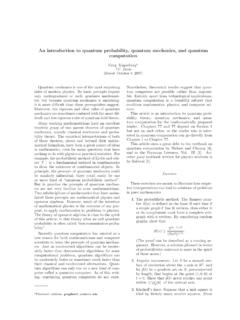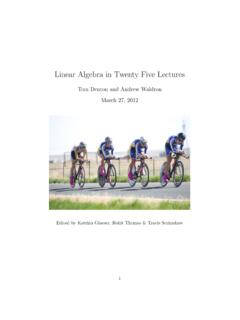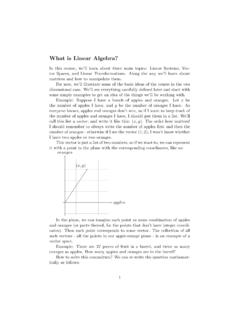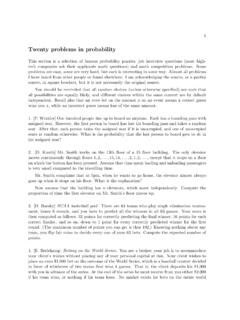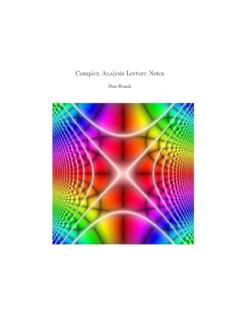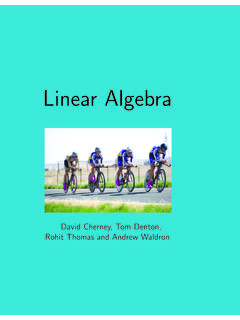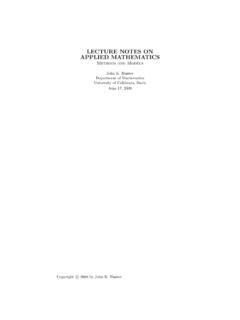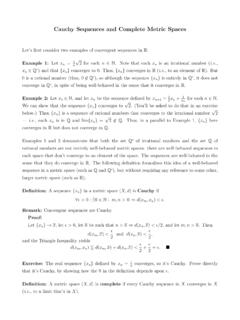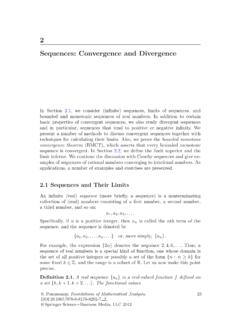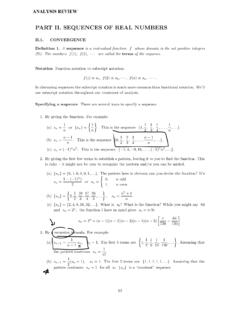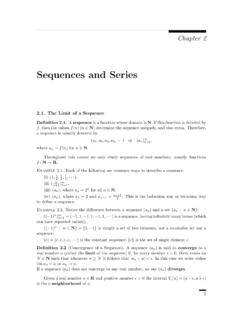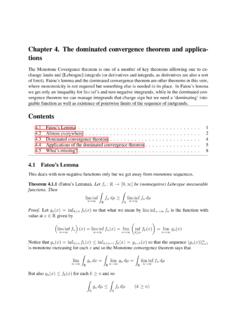Transcription of Sequences - math.ucdavis.edu
1 Chapter 3. Sequences In this chapter, we discuss Sequences . We say what it means for a sequence to converge, and define the limit of a convergent sequence . We begin with some preliminary results about the absolute value, which can be used to define a distance function, or metric, on R. In turn, convergence is defined in terms of this metric. The absolute value Definition The absolute value of x R is defined by (. x if x 0, |x| =. x if x < 0. Some basic properties of the absolute value are the following. Proposition For all x, y R: (a) |x| 0 and |x| = 0 if and only if x = 0;. (b) | x| = |x|;. (c) |x + y| |x| + |y| (triangle inequality);. (d) |xy| = |x| |y|;. Proof. Parts (a), (b) follow immediately from the definition.)
2 Part (c) remains valid if we change the signs of both x and y or exchange x and y. Therefore we can assume that x 0 and |x| |y| without loss of generality, in which case x + y 0. If y 0, corresponding to the case when x and y have the same sign, then |x + y| = x + y = |x| + |y|. If y < 0, corresponding to the case when x and y have opposite signs and x + y > 0, then |x + y| = x + y = |x| |y| < |x| + |y|, 35. 36 3. Sequences which proves (c). Part (d) remains valid if we change x to x or y to y, so we can assume that x, y 0 without loss of generality. Then xy 0 and |xy| = xy =. |x||y|.. One useful consequence of the triangle inequality is the following reverse trian- gle inequality. Proposition If x, y R, then ||x| |y|| |x y|.
3 Proof. By the triangle inequality, |x| = |x y + y| |x y| + |y|. so |x| |y| |x y|. Similarly, exchanging x and y, we get |y| |x| |x y|, which proves the result.. We can give an equivalent condition for the boundedness of a set by using the absolute value instead of upper and lower bounds as in Definition Proposition A set A R is bounded if and only if there exists a real number M 0 such that |x| M for every x A. Proof. If the condition in the proposition holds, then M is an upper bound of A and M is a lower bound, so A is bounded. Conversely, if A is bounded from above by M 0 and from below by m0 , then |x| M for every x A where M =. max{|m0 |, |M 0 |}.. A third way to say that a set is bounded is in terms of its diameter.
4 Definition Let A R. The diameter of A is diam A = sup {|x y| : x, y A} . Then a set is bounded if and only if its diameter is finite. Example If A = ( a, a), then diam A = 2a, and A is bounded. If A =. ( , a), then diam A = , and A is unbounded. Sequences A sequence (xn ) of real numbers is an ordered list of numbers xn R, called the terms of the sequence , indexed by the natural numbers n N. We often indicate a sequence by listing the first few terms, especially if they have an obvious pattern. Of course, no finite list of terms is, on its own, sufficient to define a sequence . Sequences 37. 3. xn 2. 0 5 10 15 20 25 30 35 40. n Figure 1. A plot of the first 40 terms in the sequence xn = (1 + 1/n)n , illustrating that it is monotone increasing and converges to e , whose value is indicated by the dashed line.
5 Example Here are some Sequences : 1, 8, 27, 64, .. , xn = n3 , 1 1 1 1. 1, , , , .. xn = ;. 2 3 4 n 1, 1, 1, 1, .. xn = ( 1)n+1 , 2 3 n 1 1 1. (1 + 1) , 1 + , 1+ , .. xn = 1 + . 2 3 n Note that unlike sets, where elements are not repeated, the terms in a sequence may be repeated. The formal definition of a sequence is as a function on N, which is equivalent to its definition as a list. Definition A sequence (xn ) of real numbers is a function f : N R, where xn = f (n). We can consider Sequences of many different types of objects (for example, Sequences of functions) but for now we only consider Sequences of real numbers, and we will refer to them as Sequences for short. A useful way to visualize a sequence (xn ) is to plot the graph of xn R versus n N.
6 (See Figure 1 for an example.). 38 3. Sequences If we want to indicate the range of the index n N explicitly, we write the sequence as (xn ) n=1 . Sometimes it is convenient to start numbering a sequence from a different integer, such as n = 0 instead of n = 1. In that case, a sequence (xn ) . n=0 is a function f : N0 R where xn = f (n) and N0 = {0, 1, 2, 3, .. }, and similarly for other starting points. Every function f : N R defines a sequence , corresponding to an arbitrary choice of a real number xn R for each n N. Some Sequences can be defined explicitly by giving an expression for the nth terms, as in Example ; others can be defined recursively. That is, we specify the value of the initial term (or terms) in the sequence , and define xn as a function of the previous terms (x1 , x2.)
7 , xn 1 ). A well-known example of a recursive sequence is the Fibonacci sequence (Fn ). 1, 1, 2, 3, 5, 8, 13, .. , which is defined by F1 = F2 = 1 and Fn = Fn 1 + Fn 2 for n 3. That is, we add the two preceding terms to get the next term. In general, we cannot expect to solve a recursion relation to get an explicit expression for the nth term in a sequence , but the recursion relation for the Fibonacci sequence is linear with constant coefficients, and it can be solved to give an expression for Fn called the Euler-Binet formula. Proposition (Euler-Binet formula). The nth term in the Fibonacci sequence is given by . n . 1 n 1 1+ 5. Fn = , = . 5 2. Proof. The terms in the Fibonacci sequence are uniquely determined by the linear difference equation Fn Fn 1 Fn 2 = 0, n 3, with the initial conditions F1 = 1, F2 = 1.
8 N We see that Fn = r is a solution of the difference equation if r satisfies r2 r 1 = 0, which gives . 1 1+ 5. r = or , = 2. By linearity, n 1. Fn = A n + B .. is a solution of the difference equation for arbitrary constants A, B. This solution satisfies the initial conditions F1 = F2 = 1 if 1 1. A= , B = , 5 5. which proves the result.. convergence and limits 39. Alternatively, once we know the answer, we can prove Proposition by in- duction. The details are left as an exercise. Note that . although the right-hand side of the equation for Fn involves the irrational number 5, its value is an integer for every n N. The number appearing in Proposition is called the golden ratio. It has the property that subtracting 1 from it gives its reciprocal, or 1.
9 1= .. Geometrically, this property means that the removal of a square from a rectangle whose sides are in the ratio leaves a rectangle whose sides are in the same ratio. The number was originally defined in Euclid's Elements as the division of a line in extreme and mean ratio, and Ancient Greek architects arguably used rectangles with this proportion in the Parthenon and other buildings. During the Renaissance, was referred to as the divine proportion. The first use of the term golden section appears to be by Martin Ohm, brother of the physicist Georg Ohm, in a book published in 1835. convergence and limits Roughly speaking, a sequence (xn ) converges to a limit x if its terms xn get arbi- trarily close to x for all sufficiently large n.
10 Definition A sequence (xn ) of real numbers converges to a limit x R, written x = lim xn , or xn x as n , n . if for every > 0 there exists N N such that |xn x| < for all n > N . A sequence converges if it converges to some limit x R, otherwise it diverges. Although we don't show it explicitly in the definition, N is allowed to depend on . Typically, the smaller we choose , the larger we have to make N . One way to view a proof of convergence is as a game: If I give you an > 0, you have to come up with an N that works. Also note that xn x as n means the same thing as |xn x| 0 as n . It may appear obvious that a limit is unique if one exists, but this fact requires proof. Proposition If a sequence converges, then its limit is unique.
